- Getting around Lijiang. Dont stay in the Old Towns more than 2 days, there is nothing to do. KRISS Oct 9, 2013 05:46
- 2013 Beijing Temple Fair BENNYLAU Feb 26, 2013 03:29
- Malaysian traveling from KUL - LAX vis Shanghai PVG ZATI_DY Jan 3, 2013 20:15
Nostalgic blossoms, nostalgic Yangtse South
- Views: 38425
- |Vote: 10 4
- |Add to Favorites
- |Recommend to Friends
1.
When the Song dynasty panoramic paintings, « Along the river during Qingming Festival » were exhibited, I was much intrigued, in my candid reading, by the festive spirit in which springtime travel was practiced as early as in olden times China as if in escapade from the hustles of the city. The lady in sedan chair adorned with willows and wild flower figs, with her array of escorting servants and husband on horseback commuting back from the countryside to town appear to epitomise the tradition of springtime outing, termed in old Chinese « treading the meadows » (踏青), originally a custom from the bygone « Shang Si Festival» (上巳节), or the third lunar day of the third lunar calendar month (三月三), festival dated as early as two thousand years back to the Spring and Autumn Period, whose customary practices having been absorbed beyond the Tang Dynasty into the ceremonial tomb-sweeping Qingming (Pure Brightness) Festival (清明节) always falling on the following days.
Rites of Spring
2.
It is a time when people in olden times China would walk in the fields, enjoy themselves in a picnic, hold feast along the water where a party player floats a goblet of wine on lotus leaf downstream to the next player who must drink to the toast and outwit in poetry (曲水流觞), while others would bathe in streams (祓禊), pluck orchids, fly kites, swing under the boughs, and gather to gaze at the spring blossoms...
It is also the time when households put out the kitchen fire and solemnly await the old firewood be replaced anew to start a new year, when people have to content themselves with cold dishes and would eat customarily prepared green cakes (Qingtuan 青团) during these days of Hanshi (寒食节).
In their own ways, ancient people hoped to rid themselves from any bad luck in the year, what might be conceivable as a need of the psyche to purify from the worldly cares and a yearning for the continuity of life and health.
Whatever ritual, vanished or evolved, cherished customs to embrace Nature at this time of year persist, around the Qingming Festival
Is it not what vacations are all about - to renew one's body and spirit in a trip away from regular occupation into nature, and perhaps best done in springtime than conventionally in summer?
Solitary harbinger of spring
3.
The idea of enjoying the beauty of flowers to sample springtime, I observed, has been prevalent in North Asia, and in China appraising the blossoming of Mei (梅), the Chinese «plum blossom» (the wild apricots – especially Prunus mume and Prunus armeniaca) ¹, is an archetypical pastime, in the way the cherry blossom hanami and autumn colour Momijigari are enjoyed in Japan at the change of the seasons, when the Mei bud out of winter’s frost and bloom first amidst the drab winter branches, heralding the return of spring.
In China flower viewing may not be as obsessive as in Japan where the cherry blossoming period in each region are forecasted and watched alongside the weather report by those planning flower viewing trip or giving flower party.
__________
¹ From now on « Plum » in its Chinese sense may be used to refer to P. Mume.
4.
Despite the lack of those information to track the flowering time of the plum trees, the ancient wisdom handed down a tip for the best viewing time, which is the ten-day period before and after the third solar term of the Chinese calendar, the « Jingzhe » (惊蛰), literally meaning the awakening of hibernated insects, by the thunderstorms at this time - a traditional belief of the Chinese farming culture, also welcomed as a sign that warmer days are here. Jingzhe usually occurs on the 5th or 6th of March of the Gregorian calendar. Apparently blossoming time differs across the vast territory of China, and the rest is for one to explore
We've decided to set out for our Mei trip just on the day the insects wake up, to Jiangnan (江南), South of the Yangtze River, in the footsteps of Qing emperor Qianlong, though today impossible to navigate on the Grand Canal all the way from Beijing down to Hangzhou, to cities along the Yangtse southern reaches - Nanjing, Yangzhou, Zhenjiang, Wuxi, Suzhou, Hangzhou with excursions to a couple of the old water towns of Tongli, Wuzhen and Xitang.
Sampling disillusionments amid the « French » wutong trees?
Nanjing city
5.
On arrival to Nanjing a light rain had fallen. A chill enveloped the city like any featureless Parisian morning, or evening… on an early March day. Transferring to downtown, I saw no sign of spring. I let Artur² fix the rain gear. My iPod shuffled momentarily to Karajan with the Berlin Philharmonic playing Vivaldi’s L’Inverno F minor Allegro non molto. Forlorn sycamores exposing bird nests on empty branches arrayed all around the city, and remained the leitmotif of our first impression of the city. In the evening we soaked in the flickers of real and reflected colours of Qin Wei Hu in the rain, and we were finally contented to slumber in the warm and feathery tavern bed that I knew of afterwards in this part of China all being made up of sheets and quilts in blissful Suzhou silk, let the rain alone pattering on the panes.
The next morning, we followed the locals to stroll by the Xuan Wu Lake, which was still unawake in its new willows and moodiness in the rain. We conjectured about the first sighting of Mei yet to loom…
_________
(² Arthure est le chevalier fictif de la Faerie Queene)
Plum Blossom Festival
Nanjing – Meihua Shan (Plum Blossom Hill)
6.
The severe winter befallen in central and southeastern China in January and February (2008), having also overshadowed the Lunar New Year of the Rat, I ponder, might give new meaning to this year’s returning spring.
In Nanjing, the annual Nanjing Plum Blossom Festival garners much more attention to local day-trippers to sample spring than tourists.
At the southern foot of the Purple Mountain (Zijin Shan), in the vicinity of the two must-see attractions of the Zhong Shan National Park, another name of the same Mountain - the Dr Sun Yat-Sen Mausoleum and the Ming Xiaoling (Mausoleum of the Ming Dynasty founder, emperor Zhu Yuanzhang who first made Nanjing China’s capital in year 1368), the Plum Blossom Hill, embraced by the winding, cedar and stone animal flanked Sacred Way, home to more than 30,000 plum trees in 350 cultivars, is a worthy detour at this time of the year from the two touristy must sees.
Still it is probably the most crowded, noisiest plum flower viewing spot in China. The other large scale Plum Flower Festival of such kind is held annually in Wuhan’s East Lake, where China’s Botanical Research Institute for Chinese “Plum” is also located.
We waded through the crowds shoving their way to the vantage Fraternity Pavilion, plum trees partaken by families picnicking underneath the blossoms, amateurish Suzhou Pingtan ballad singers and Taichi exercisers, to the valley and hillside blanketed by crimson and red plum trees since at least the Ming Dynasty being then the imperial plum garden and the environ to the original site of Linggu Temple, lending the populace’s name of Plum Blossom Hill to that part of the Purple Mountain, itself known by its purple hue surrounding the mountain in the misty month of the Mei blooming.
The Festival is awarded China’s top ten « Chinese Festival Award » in 2008.
7.
The Plum Blossom Hill also buried one of the three heroes of the « Romance of the Three Kingdoms», Sun Quan, emperor of the State Wu during the Three Kingdoms Period (220-280AD), very graceful place under the spring canopy of home-grown Mei - the Nanjing Red (南京紅), Green Calyx and Double Blossom (复瓣绿萼), Jade Butterfly Button (扣子玉蝶), Rust Red Bloom (铁骨红)..., budding in the wintry frosts, delighting men’s eyes with their blossoming glow each spring, then returning in eternal cycle their beauty to the earth.
An emperor's « spring tread »
Yangzhou - Shouxi Hu (Slender West Lake)
8.
After Nanjing we continued to promenade to the Emperor Qianlong's favourite retreat, during his six voyages to the Yangtse south, in the city of Yangzhou, and spent a good afternoon at Shouxi Hu, the Slender West Lake, a narrow river being turned to a leisure garden for the devoted tourist, the Emperor Qianlong.
Though not being given a pagoda built overnight to our delight, we were amazed in the heart of experience of every intimate step in a south Chinese landscaped garden, unfolding every novel scenery, in meticulous details, of the pagodas and pavilions in the mist, of weeping willows and blossoming trees, as we sailed through spanning bridges one after another along the lake, until beholding the changing hues of the crepuscular firmament.
9
Seldom has been reality as orderly symmetrical and harmonious as one sees here that were we not stepping into a Chinese brush painting depicting Li Bai's bidding farewell to his friend Meng Hao ran at Guangling ?
Leaving the Yellow Crane Pavilion,
you set out to the east,
to Yangzhou, the mist covering
the water, the flowers making
a blaze of March colors
against a single sail
fading into the blue, distant skies
Only waves of the Yangtse River
come in sight, rolling toward the horizon
Li Bai (701-762)
(100 Poems from Tang and Song Dynasties, Translated by Qiu Xiaolong, Better Link Press, 2006)
Not surprisingly the place nurtured frequenters to the lake - a group of eight painters and calligraphers, the School of the Eight Eccentrics of Yangzhou, known revolutionaries of established conventions of the Chinese Art in favour of an expressive and individualistic style, and best represented by the orchid, bamboo, stone paintings and calligraphy works of Zheng Banqiao 郑板桥 (1694-1765), who wrote, "I dreamt of Yangzhou, awoke and wondered if Yangzhou was dreaming of me"....
Of misty month and ancient flower
Yangzhou – Qiong Flower Temple
10.
Emblematic of the city, the Qiong flower (琼花) is an olden flower indigenous to Yangzhou, said to be inherited from the Han Dynasty (206BC to 220AD), and legend told its geminating from a piece of jade from the Heavens. I couldn’t find any at the Shouxi Hu. Intent on seeing them, we paid visit to the Qionghua Temple (built 11 BC) home to an ancient, unique Qionghua tree originally planted there some 2,000 years ago but died out in the year of the fall of the Song Dynasty in 1276. Today’s Qiong flowers are a new cultivar planted in the Song Dynasty twenty years after the extinction of the original species.
11.
In the way they fooled the extravagant Sui Emperor Yang Di who ordered the digging of the Grand Canal from the then eastern capital Luoyang down to Yangzhou and sailed down with 20,000 men on thousands dragon boats, just to pay tribute to this flower in bloom at the temple, these capricious flowers only faded before he came and led the emperor to his fall… we came only to find the bare ancient tree in the courtyard of a charming complex of gardens and pavilions designed for flower viewing and moon gazing by ancient poets, in a backdrop of rusty factory buildings.
From the loudspeaker of a guide ushering in tourists who quickly besieged the temple, I learnt that they are still flowering today, after Qingming, when they will cheer up the garden for a brief two weeks a year.
Conspicuous and refreshing in sight, the Qionghua are gigantic silken white flowers seemingly composed of eight white dancing butterfly florets sucking nectars from the ring of abundant pearl-bearing green stigmas. The rare flower is called the wild Chinese viburnum (botanically Viburnum macrocephalum of the Caprifoliaceae family).
Scattered shadows - a « Plum Blossom Appreciation Manual » …
12.
Botanically the Mei, Prunus mume is a species of the Asian apricot in the Rosaceae family. The so named plum, cherry, peach, apricot, pear trees whose blossoms are very much ornamental in North Asia come from the same family. In China the P. mume is also extensively cultivated for its edible kernel, called the plum fruit in Chinese and hence the confusing appellation of plum trees and plum flowers ..
Bequeathing a history of almost three millennia of cultivation and appreciations, the Mei is a profound symbol in the Chinese tradition.
Aficionados believe that the plum flowers are best appreciated in their buds unfolding into blossoms. Sparse branches of inflorescence are preferred to dense, old trees to young and slender to expansive.
In essence they are appreciated in three aspects : Firstly the appreciation of the hues of the blossoms – among the blush, pink, purplish red, pale yellow, light green, creamy and pure white , the green and dark red are the rarest. Secondly the appreciation of the postures of its branches – A Chinese plum tree has the handsome silhouette of an enlarged bonsai. The Magpie on Mei bough together make a classic art motif depicting joy - coming to the tip of the brow - in Chinese paintings. They are classified into the Straight Branch, Reclinate Branch and Swimming Dragon Branch types to one’s individual taste. Thirdly the appreciation of the scents – the nose is a difficult faculty…
A thousand-mile view in a flight of stairs
Wuxi - Meiyuan (Plum Garden)
13.
The Mei trees are very often used as part of the meticulous arrangement in the Chinese classical gardens. The gardens in Jiangnan always reflect the metaphysical importance of natural beauty in Chinese culture. Roaming in any garden in Suzhou, we are always to stumble upon the delights of Mei blossoms whether saluting through a bamboo-framed window, wavering in a courtyard, amid Taihu stones, or reclining upon a pond.
While those heritage private gardens in the historic city of Suzhou are exemplary re-creation of natural landscape in miniature, the Rongs family Meiyuan, located at 7km west of Wuxi, is a classical natural landscape garden at large. Backed onto Dragon Mountain and overlooking Lake Tai, the Wuxi Meiyuan unifies the elements based on the principles of feng shui - water, mountain, stretches of plum trees dotted with handsome architecture of pagoda, pavilions and rocks, each of the elements interacting with the others and creating a balance, in an arrangement of smaller gardens within the larger garden in the private precincts, altogether promoting the harmonious relationships between nature, the elements of the garden, and the observer - the Mei viewer.
14.
Some 5,000 Mei trees in 40 varieties and as potted plants or bonsai have been planted in the Wuxi Plum Garden, alongside with other classical Chinese trees like the ginkgo trees and the scent-bearing osmanthus trees. It also exhibits several botanic theme gardens and is serviced with teahouses.
Knowing that climbing up a pagoda is a symbolic soul searching act in the Chinese tradition, we tried to see what is yet to offer and climbed up the hexagonal three-storey pagoda built by the Plum Garden former owner to commemorate their mother. An imposing vista of hillside painted with a delicate colour wash of crimson and Taihu dotted with barques veiled in the mist afar opened its arms to us, sufficed to captivate the spirits.
Vague scent afloat
Suzhou – Deng Wei Hill, Guangfu Town, southwest of Suzhou
15.
Ah! The first blossoms how they are perfumed! (« Ah! les premières fleurs, qu'elles sont parfumées ! », Paul Verlaine)
The Mei gives out a subtle fragrance beyond description that I so wish to capture in a flacon. Perhaps what Mei intoxicate people since the centuries are their voluptuous scents enhancing all the more their beauty.
The Qing emperor Qianlong paid pilgrimage to the plum blossom on the hillsides of Deng Wei in Suzhou in each of his six promenades to the Yangtse South. A Q’ing official was so inspired that he left calligraphy of three characters of overwhelming ambience, « Xingxuehai » (香雪海), to depict the hillside of snow white Mei blossoms there, as a « sea of scented snow »…. Needless to say more!
The Mei trees here are predominately white double blossom with edible kernel type, stand in pleasantly hilly terrain, and the scale of their profusions suffices to impress with the spectacular snow effect. Since ancient times farmers in Deng Wei used to make a living from plum cultivation. Today there are collections of indigenous, Japanese and European varieties, cultivars and hybrids.
16.
The two historic vantage points, beloved by the Q'ing emperors, stand as an indication to distance when walking uphill amidst the trees canopying in profusions. A remake to their original appearances, the Plum Blossom Pavilion is an excelled embodiment of the five-petal Plum Blossom - pentagonal tilted roof structure, columns, railings and floor tiles all in the shape of the plum blossom petals and adorned with the final touch of a copper crane at rooftop. Further downhill is the House of Aroma of Plum, now serving as kind of museum of the history of the Chinese Mei. Both command a strategic view overlooking the Sea of Scented Snow downhill. It is unsurprising that this place had been reputed to be muse for emperors, poets and calligraphers.
Mei fanciers could further move about to the pier at Xishan Daqiao - we were too late to make it to - and take a boat ride in the Lake Tai, to appreciate the tinted colours fringing the West Hill island, in the midst Lake Tai.
Reminiscing the blossoms
Hangzhou - Chao Hill, Yuhang
17.
We sailed on the Grand Canal overnight from Suzhou and landed the next morning at the canal's southern end in Hangzhou. Chao Hill is located in Yuhang, some 30 km away from Hangzhou in its north suburb.
A Plum Blossom Festival had just been held there (from 14 February to 8 March in 2008), alarming news that further down south here the blossoming period was about the end… Chao Hill despite its modest height of only 306m is the highest point in Hangzhou. A small walk trespassing some playgrounds, park facilities, pony rides and even bridal photo service…, man’s efforts only to deform nature, led us to the 1000-year old Mei plantation. Within the first gate, the fields, known as another ten miles of sea of fragrant snow, did not fail us with its white and pink splashes of Mei, mostly shrubby here, blooming to full now. Intoxicated, I faltered forward on the path almost invaded by Mei shrubs, petals around me falling, and we were indeed, as the poets suggested, as if being grasped by the blossoms on our sleeves.
I spotted the six-petal blossoms famous in Chao Hill that reminded me of what I researched about the plum, whose five petals symbolise the Five Fold Happiness in the Chinese tradition – Luck, Prosperity, Longevity, Happiness, and Wealth. What then is our rare find, the sixth petal revealing to us…? I contemplated the blossoms - is it the reminder they give us of the beauty of life or something else in life, simple and strong enough…?
18.
Further on, the inner sanctuary, called the Great Light Hall is where enclosed the Song Mei Pagoda and Floating Scent Pavilion, respective viewing spots of the two ancient plum trees planted in the Song and Tang Dynasties. There are five ancient plums still in existence and flowering in China, named respectively after the time in which they were planted - the Chu Kingdom (403-429 AD) , the Jing Dynasty (265-420 AD), the Sui Dynasty (588-618AD)³ , Tang Dynasty (618-907 AD) and Song Dynasty (960-1279 AD). Disappointingly the Song and Tang Mei have already blossomed in February and lost their blooms to the earlier snowstorms.
Reminiscing Jiangnan, it is a feeling bound to resonate with any one having encountered with the blossomed Mei. Mei enthusiast Wu Chong-shuo (吴昌硕), artist and founding president of China's Xiling Seal Engravers Society (西泠印社) in Solitary Hill, West Lake, was so nostalgic to return to die and be buried amidst the ten miles of Mei scented sea of snow in Chao Hill, apparently his root.
_________
³ The Chu Plum is housed in Zhanghua Temple, Shashi District, Jingzhou, Hubei Province; Jing Plum in Jiang Xin Temple, Huangmei County, Hubei Province; and Sui Plum at Guoqing Temple, Tiantai Mountain, Zhejiang Province
Of Mei and Crane
Hangzhou, Solitary Hill, West Lake
19.
The mist and rain we so hated and protested as bad luck on a journey are blessings to the Longjing tea planters near West Lake in Hangzhou, as they nurture the very best quality Dragon Well to be picked in early spring, before the Qingming Festival, and, I suspect, endeared to the admirers of the West Lake, too.
Every morning while we were in Hangzhou, a light rain fell but it has now become so natural that it is integral to the West Lake. Her jade green willows wavering in the mists on the Su Causeway, West Lake seems ever the unequaled embodiment of springtime in China…
Traditionally to the Mei connoisseurs, the appreciation of Mei should not confine to a bright, cloudless weather. The best ambiences are lightly overcast, misty, in a light rain, a little snowy, in a daybreak sun, in crepuscular light, in the moonshine glow…
Not the grandest profusions but appraising plum blossoms in the heart of the West Lake, on the Solitary Hill island presents a different mood, where the morning mists usually clear away the smog, and tourists are sparse there, too.
20.
Strolling along the northeastern edge of the island, we revisited where the Song Dynasty poet, painter and calligrapher, Lin Bu (林逋), or the Fleeing Immortal, known recluse in the Solitary Hill, planted 365 plum trees to make his living by selling the fruits of a plum tree as his daily budget in a year and flew cranes at the Crane Pavilion, leading for twenty years a hermitic literati’s life doting on his plum trees as wife and pet cranes sons!.
Other viewing spots are inside the compound of Xiling Seal Engravers’ Society, west of Zhongshan Garden on the Solitary Hill island, and Lingfeng Hill in the Botanical Garden in the West Lake environ.
The Plum Blossom is very much home to the South of the Yangtze being a natural vegetation there and having long, rooted cultural association among its people. Their blooming promises the return of spring and warm days. When the trees are laden with ripened plum fruits it foretells the end of spring days when drizzles start to annoy the region…
Petals around me falling…
21.
Moon atop a plum tree, scattered shadows, vague scent afloat… Tantalising, the allures of Mei are best discerned by Lin Bu and expressed in his verse, classic on the Chinese Plum Blossom :
How Plum Flowers Embarrass a Garden
When everything has faded they alone shine forth
encroaching on the charms of smaller gardens
their scattered shadows fall lightly on clear water
their subtle scent pervades the moonlit dusk
snowbirds look again before they land
butterflies would faint if they but knew
thankfully I can flirt in whispered verse
I don't need a sounding board or wine cup
Lin Bu (967-1028)
(Poems of the Masters; translated by Red Pine/Bill Porter, Copper Canyon Press, 2003)
22.
He is the lasting friend, the wintry ally of the pine tree and bamboo, the virtuous gentleman with the chrysanthemum. She is at once the goddess of feminine beauty and fertility, the glamourous Southern Song princess Shou Yang in her plum blossom allure, the incarnated Plum Muse accompanied by the jade bird servant in the dream of a Sui scholar in Mount Loufu (a plum blossom viewing spot in Guangdong), the Mei wife of Song recluse Lin Bu….
Whether their aesthetic value to scenic spots, single beauty or in profusions, or voluptuousness to the senses, or metaphorically, their subtlety left me wanting more...
ooOoo
Memory, memory, what do you want of me? (« Souvenir, souvenir, que me veux-tu? », Paul Verlaine)
_______________
Variations on the Plum Blossom Theme
23.
Last but not least, a piece of Chinese classical music inspired by the Plum Blossom - « Three Variations of a Plum Blossom Theme » (梅花三弄), 1425, music in Guqin, the Chinese 7-string zither
http://www.youtube.com/watch?v=HYtbXnLnkPA
Photo titles :
1. scattered shadows fall lightly on clear water (verse of Lin Bu) , Deng Wei Hill, Suzhou
2. Spring willows, West Lake, Hangzhou
3. On a bough, Meihua Shan, Nanjing
4. Vermillion blossoms, Cinnabar plum cultivar, Deng Wei Hill, Suzhou
5. Sycamores, locally called the French Wutong trees ((in fact the hybrid Platanus x hispanica), at Zhan Yuan Lu, Nanjing
6. plum flower pilgrims to Pavilion of Fraternity, Nanjing International Plum Festival, Plum Blossom Hill
7. Tomb of Sun Quan, in the shade of red plum trees, Plum Blossom Hill, Nanjing
8. Sailing into a painting, Slender West Lake, Yangzhou
9. Crepuscular firmament tainting the Slender West Lake, Yangzhou
10. Qiong Flower temple, Yangzhou
11. the legendary Qiong Flower, being adored since the antiquities
12. the Swimming Dragon cultivar of the Chinese Plum, Meiyuan, Wuxi
24
13. Kaleidoscopic blossoms, Meiyuan, Wuxi
14. The riotous wild apricots painted an impressionistic colour wash of a myriad of pink, Meiyuan, Wuxi
15. The Sea of Plum flower scented snow, Deng Wei Hill, Suzhou
16. A handful of Green Calyx Blossoms that make up the Sea of Scented Snow on the hill of Deng Wei, Suzhou
17. Six-petal plum blossoms, Chao Hill, near Hangzhou
18. Plum from the Tang Dynasty (618-907 AD), Chao Hill, near Hangzhou
19. Our encounter… with Spring on Su bank, West Lake, Hangzhou
20. Beautiful allure… of the plum shrubs in bloom, at Solitary Hill, West Lake, Hangzhou
21. Wuxi Meiyuan
22. Red blossoms and blue sky, Wuxi Meiyuan
23. Plum blossom inspired… , a gate at the plum garden at Chao Hill, Yuhang, Zhejiang
24. Plum blossom inspired…, pastries in plum flower shape, Wuzhen, Zhejiang
25. a taste of Jiangnan water town, Xitang, Zhejiang
____
The Yangtse South (Jiangsu, Zhejiang) – among China’s best destinations ♥ ♥ ♥ ♥ ♥ (personal rating)
® TheFaerieQueene 2008
Itinerary
25.
Nanjing -Yangzhou - Zhenjiang - Wuxi - Suzhou (+Tongli) - Hangzhou (+Wuzhen, Xitang)
Nanjing (1 hour 15 minutes by train, or 2 hours by bus) to Yangzhou (1 hour by bus) to Zhenjiang (50 minutes by D train, or 2 hours by bus) to Wuxi (45 minutes by bus) to Suzhou (overnight boat 17h30 - 7h; nota: bus journey takes 3 hours)) to Hangzhou
...Suzhou excursion to Tongli (30 minutes by bus)
...Hangzhou excursion to Wuzhen (1 hour by bus)
...Hangzhou excursion to Xitang (1 hour by bus to Jiashan, another 20 minutes by minibus to Xitang)



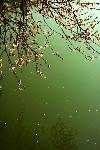
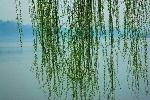
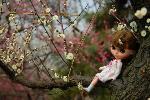
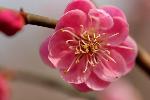



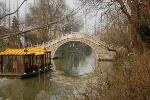

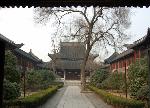

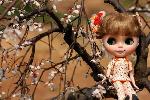

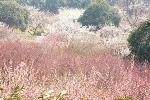

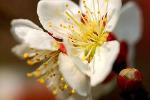

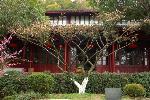
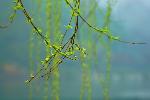
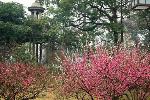
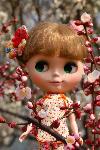
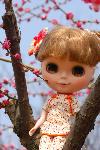

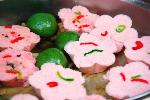

 Copyright © 1998-2025 All rights reserved.
Copyright © 1998-2025 All rights reserved.